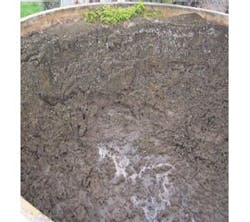Waste Not
About the author: Nick Nicholas is technical sales manager, business development, for Genesis Water Technologies Inc. Nicholas can be reached at [email protected] or 877.267.3699.
A petroleum refinery was classified as a hazardous waste generator under the Resource Conservation and Recovery Act (RCRA). As part of this classification, refineries are required to have a waste minimization program in place. The RCRA is stringent in its regulations, with high fines levied to companies that do not comply with the regulations set forth by the U.S. Environmental Protection Agency (EPA) in this legislation.
The refinery has a wastewater treatment plant with a 320,000-gal-per-day design capacity. The wastewater generated in the plant flows through the following treatment processes: a primary clarifier, a dissolved air flotation (DAF) unit, an activated sludge unit and a secondary clarifier. A portion of the sludge from the activated sludge system is returned to an aerobic digestor and the remaining sludge is recycled back to maintain the necessary food-to-microorganism ratio.
The refinery experienced issues dealing with the costs associated with hazardous waste disposals and maintaining compliance with the RCRA.
Meeting Regulations
The aerobic digestor at the plant has a 265,000-gal capacity. Solids from the aerobic digestor are considered non-hazardous waste; after dewatering, they are disposed of in a landfill.
The Genesis Water Technologies BIO PS10 Series natural microbiological product provides an alternate solution for disposal of hazardous organic compounds and offers a long-term, cost-effective solution to wastewater treatment problems in the petroleum refining industry. The products were developed for biological degradation of various hydrocarbons in wastewater, surface water, soil and groundwater. The products are composed of specifically selected blends of naturally occurring strains of freeze-dried bacteria with exceptionally high disintegration capabilities.
Prior to using the BIO Series product, the refinery dewatered and shipped approximately 105 tons of solids from the digestor at a cost of about $114,000. The first dosage of the BIO PS10 was initiated into the digestor in order to reduce the amount of sludge handling. The products have blended strains of bacteria that are highly effective in degrading oils and petroleum hydrocarbons that might have escaped through the treatment units.
After the depletion of these oil/hydrocarbon compounds, cell biomass itself becomes a food source. The dewatering characteristics of the sludge are improved. Application of the product resulted in a significant reduction of solids content within the digestor system, and the refinery has not hauled away any additional sludge since.
The concentration of solids in the digestor is being maintained at a fairly consistent level. The bioaugmentation of the BIO product has resulted in savings of more than $105,000 for the full year.
The DAF unit is designed to remove oil, grease and solids from the wastewater influent before the effluent water is sent to the aeration tank. The solids removed from the DAF are considered a “listed hazardous waste” for the petroleum refinery. In order to comply with the EPA’s 90-day rule, the refinery was required to dewater and transport this hazardous waste for disposal through incineration or fuels blending. This rule also determines the frequency of the dewatering cycle and becomes an important cost factor.
Treating Hazardous Waste
Approximately 125 tons of DAF solids were disposed of prior to conducting the field case study, costing more than $305,000. Due to the results obtained in sludge reduction in the digestor process, the refinery decided to pilot study the possibility of treating its hazardous waste (up to 10% oil and grease) using the BIO Series product. A section of the aeration basin was selected for this study.
Within two weeks after the initial treatment, the sludge batch was completed and met the requirements for a normal landfill. This refinery has not sent any DAF waste out for disposal and has saved more than $205,000 since it conducted the successful pilot study.
Using the BIO product also has provided a reduction in the overall ammonium nitrate content and helped this particular refinery to meet the state’s discharge limit requirements. The total suspended solids remained consistent in the digestor over a six-month period even though 160-lb dry weight basis of biosolids were being added daily.
Using the BIO PS10 product has provided reduction in both ammonium nitrate content, sludge and oil/hydrocarbon degradation for this client. This solved the client’s issues with maintaining discharge compliance and reducing costs of disposal.
Download: Here
